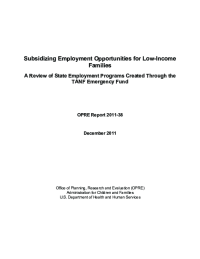Subsidizing Employment Opportunities for Low-Income Families
A Review of State Employment Programs Created Through the TANF Emergency Fund
Subsidized employment programs provide jobs to people who cannot find employment in the regular labor market and use public funds to pay all or some of their wages. In 2009 and 2010, states could access funding from the Temporary Assistance for Needy Families (TANF) Emergency Fund, which was established under the American Recovery and Reinvestment Act (ARRA) to create or expand subsidized employment programs. When the fund expired on September 30, 2010, states had placed more than a quarter of a million people in subsidized jobs, making this the largest subsidized employment initiative in the country since the 1970s.
The Subsidized and Transitional Employment Demonstration (STED) project, sponsored by the Administration for Children and Families (ACF) in the U.S. Department of Health and Human Services, will conduct rigorous evaluations of several subsidized employment programs for disadvantaged workers over the next few years. This report presents findings from the first phase of the STED project — a review of subsidized employment programs that operated with support from the TANF Emergency Fund. It is based on telephone interviews with administrators in 48 states, tribes, and territories that received Emergency Fund support for subsidized employment; site visits to eight programs; and reports that states provided to the research team.
Key Findings
- While states and localities often had less than one year to create or expand their subsidized employment programs, many were able to mount relatively large-scale efforts. In all, 15 states placed over 5,000 people in jobs. Four of those states — California, Illinois, Pennsylvania, and Texas — each placed more than 25,000 people, accounting for over half of the national total. Nationwide, about half the placements were summer jobs for youth.
- Responding to the flexibility allowed under the Emergency Fund, states and localities implemented a wide range of programs. Programs differed in the participants targeted (most were not limited to TANF recipients), the type of employers recruited, the structure of the subsidy, and the size of the program.
- In many programs, participants worked for private employers, who were reimbursed for all or part of participants’ wages. This model contrasted with that of most earlier subsidized employment initiatives, which placed participants in nonprofit or public agencies.
- After funding ended, many of the programs also ended, and others sharply reduced the number of people served. Only a few states continued to operate at the same levels as previously, and these were states that, for the most part, were operating subsidized employment programs using TANF funds before ARRA was enacted.
States’ experiences with the TANF Emergency Fund subsidized employment programs may yield valuable lessons for future efforts to create jobs for disadvantaged groups.






